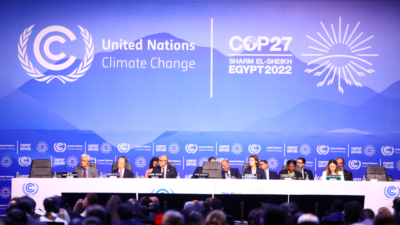The Sleepwalking COP
Thoughts on COP27, this year’s climate conference
 It’s two weeks since the end of this year’s annual Conference of the Parties to the international climate treaties, COP27, held in Sharm el-Sheikh, Egypt.
It’s two weeks since the end of this year’s annual Conference of the Parties to the international climate treaties, COP27, held in Sharm el-Sheikh, Egypt.
You might have noticed an odd vagueness in accounts of this year’s COP. These annual meetings are huge media events — understandably, since they are the highest-level international event on climate change, even if this over-states their importance relative to other ongoing work — but there was a strange vagueness, and near-silence, in reporting on this COP.
Every year’s COP is a huge media event. This is understandable, since these are the highest-level forum for official international action on climate change, even if coverage tends to overstate the important of the big annual meeting relative to ongoing work in other forums. But this year was different.
The first few days looked the same as usual. There was high-profile coverage in all major news outlets, including new special sections reflecting the prominence of climate change in the NY Times, Washington Post, Guardian, and others. Then after a few days the flow of reporting slowed, with most stories less prominently placed, until a short burst of coverage at the end of the meeting. Even weirder, the many policy and advocacy organizations — environmental groups, industry groups, and others — who always rush to publish within a few days of the end of the COP, saying what it meant and spinning it to their purposes, have offered just vague speculation or in many cases not spoken at all.
These are all manifestations of the weakness and strangeness of this year’s COP – its frustration, its preoccupation with symbolic and procedural matters, and its disconnection from the urgency of climate action. Even before the COP, expectations for this year’s COP were low and the disconnect between these low expectations and mounting alarm about climate change – driven by a year of extreme impacts and projections of more and worse to come, soon – was extreme. On the multi-year calendar of COP work, this was not expected to be an important one. Preparation, both in inter-sessional meetings and in diplomatic efforts by the Egyptian host government, was weak. And the world was distracted by a bunch of short-term crises. Yet even relative to this low bar, this year’s COP managed to disappoint, in several ways.
Most importantly, it achieved no progress on multiple issues related to cutting global emissions and stopping climate change. There was no progress on getting national governments to state stronger ambitions in their NDCs, in the additional specification of global targets, or even in non-binding language regarding intentions to cut fossil fuels.
There was even, briefly, alarm that the COP might fail to re-affirm the 1.5°C ambition from Paris. As with several other points of conflict, this was ultimately resolved with a decision simply to repeat language adopted at prior COPs. But the arguments over this were quite disturbing, reflecting a seeming inability to acknowledge and simultaneously hold in mind two propositions that are even in slight tension: the recognition that, due to long delays getting to work, meeting the ambition of limiting global-average heating to 1.5°C above the pre-industrial level is now virtually impossible absent use of solar geoengineering (we’re already around 1.1 – 1.2°C; and the absolute imperative to cut emissions as rapidly as possible, even if 1.5°C is out of reach and the actual effect of efforts will be to limit by how much it is exceeded. Rather, in many arguments about the status of the 1.5° ambition, the two sides each want to prioritize one of these propositions and downplay or ignore the other. But the hard thing – or rather, one of the many hard things – about the present status of climate policy is that these are both true.
 Looking broadly at the weakness, dissembling, and comforting delusion on these matters related to emissions may suggest that possibility of deep structural weaknesses in the whole approach being taken in international climate law. Even from a narrow and short-term perspective, the lack of progress on emissions cuts and related matters represents a huge lost opportunity. The first “global stocktake” authorized by the Paris agreement, a comprehensive assessment of progress toward the agreement’s goals, is to be conducted next year. The failure thus far, including at this COP, to make any progress in fleshing out plans and procedures for the global stocktake makes it even less likely than hitherto that this will be a meaningful assessment of (inadequate) progress and an effective motivation for stronger national efforts.
Looking broadly at the weakness, dissembling, and comforting delusion on these matters related to emissions may suggest that possibility of deep structural weaknesses in the whole approach being taken in international climate law. Even from a narrow and short-term perspective, the lack of progress on emissions cuts and related matters represents a huge lost opportunity. The first “global stocktake” authorized by the Paris agreement, a comprehensive assessment of progress toward the agreement’s goals, is to be conducted next year. The failure thus far, including at this COP, to make any progress in fleshing out plans and procedures for the global stocktake makes it even less likely than hitherto that this will be a meaningful assessment of (inadequate) progress and an effective motivation for stronger national efforts.
Instead of progress on efforts to stop climate change — or even serious attention — the predominant focus of COP27 shifted to a cluster of matters related to dealing with current climate impacts, financial assistance to developing countries, and historical responsibility for climate change. It’s not that these issue aren’t crucial – they are, at least the adaptation and finance parts. Many climate impacts are already devastating, far beyond the resources of the affected countries. And the failure of industrialized countries to fulfill their prior financial commitments – together with the opportunistically exploited ambiguity re the specific meaning of those promises, in particular the apportioning of total amounts between public/private, grant/concessionary/market, etc. – is shameful and must be corrected. But these actions will achieve little or nothing in actually reducing climate change. Ironically, with continued inadequate progress on cutting emissions (gross or net, I’m not addressing those issues here but will do so in future posts), progress on these impacts-related matters won’t even do much to reduce the severity of realized harms in vulnerable countries. Impacts will get worse, and the reduction of harm achievable through adaptation in time will be limited.
Beyond the single-minded focus on impacts, adaptation, and finance, even within this area the COP mainly focused on just one issue: Will there be explicit recognition of loss and damage (L&D) as a category of effects and responses separate from adaptation, and will there be a separate financial vehicle for L&D payments? I’ll discuss L&D in more detail in a separate post, and just summarize the highlights here. The separateness of loss and damage from adaptation is ambiguous and contested. But insofar as it can be separately identified, L&D isn’t even about strengthening the capacity of vulnerable countries to reduce realized climate harms, it’s about monetary compensation for harms already incurred. It might be analogized to a payment for tort liability, or to an insurance payout — with the applicability of these two framings or analogies intensely contested — or something in between these, if such a creature exists.
The outcome on loss and damage — the last-minute agreement to establish a new funding vehicle – is more empty symbolism, with a dose of procedure. There is agreement that such a funding vehicle will be established. But there is no agreement on what it will do, or how it will work. Those matters, which will be highly contentious, were all left for future negotiations. There is not even any agreement or commitments on funding. The few unilateral national commitments to provide L&D funding were announced before the agreement on the new funding vehicle and it’s unclear how, or whether, they will be incorporated into the new vehicle. And relative to any estimate of climate damages or the cost of effective adaptation, the size of these commitments, all of order 10’s of millions, are too small by orders of magnitude.
In addition to these weak and unhelpful aspects of the COP, there are additional things that were affirmatively bad, or very strange:
The bad:
-
- The prominence of fossil interests advancing sketchy clean-fossil and bridge-fuel claims, and the solicitous treatment of these by the host country – strange dissonances with a climate conference that we’ve seen before (Anyone remember the celebration of coal around COP24 in Katowice Poland in 2018?), and which we may see again, perhaps even more strongly, at next year’s COP in Dubai. There are huge opportunities in carbon removal and sequestration, which may well be crucial in limiting climate change, but opportunities for exaggerated and false claims are huge and oversight and control are much too weak.
- The limited degree of interest and engagement from senior political leaders, without which no meaningful progress will be made.
- The distraction from the real urgent work to be done, at every level, down to basic logistics of running an international meeting at which real work can be done (which requires functioning facilities, food and water, bathrooms, etc.)
The strange:
-
- The position of the United States. The extraordinary scale of clean-energy and infrastructure expenditures in recent US legislation might be the most promising thing happening this year on climate change. But the design of these initiatives is reflecting current US domestic political priorities – meaning the huge expenditures are linked to a protectionist agenda. They are thus likely to be less effective in reducing global emissions than they otherwise could be. They’re also oddly illegible in the terms of international action and debate. They aren’t even linked to any top-level statements about increased US ambition to cut its own emissions. You thus get the strange picture of the US showing up expecting applause for these – and they do deserve applause – and the rest of the world treating them as non-relevant, non-responsive, etc. True, these expenditures are not “climate finance” in the canonical international meaning of the term; and big increases in climate finance are imperative, particularly for adaptation. But they are serious steps, in a highly constrained legal/political environment, toward faster progress in stopping climate change.
- The increasing shift in focus, even for climate finance, toward ad hoc separately crafted deals, bilaterally or among small groups of countries, struck with individual developing countries. Last year South Africa, this year Egypt and Indonesia (the latter not even finalized or announced at the climate COP, but a the G-20 meetings in Bali). The developing countries en bloc fairly regard these as peeling off individual countries for side deals. But in the absence of meaningful progress or even seriousness of debate in the FCCC, they’re what’s happening and clearly better than nothing.







Reader Comments